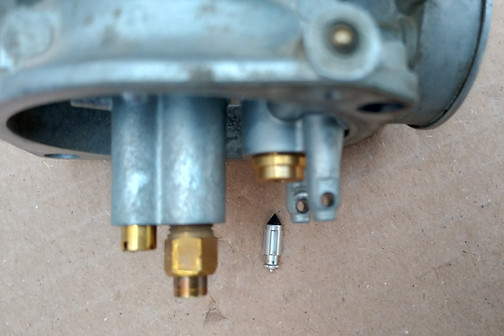
Float height
In carburetors, fuel is stored in the carburetor bowl and then delivered to the jets as needed. The fuel level in the bowl is regulated by a float mechanism. When the bowl is filled, the float rises and closes the valve supplying fuel. As fuel is used, the float descends, opening the valve to allow more fuel into the bowl. This mechanism ensures a consistent supply of fuel to the jets for proper engine operation.
Float Hight is too high: If the float height is set too high, it will cause the fuel level in the carburetor bowl to rise excessively. This can lead to fuel overflowing into the engine uncontrollably, resulting in a rich fuel-air mixture. In turn, this can cause issues such as poor engine performance, fouled spark plugs, and increased fuel consumption. Therefore, it's crucial to ensure that the float height is properly adjusted according to the manufacturer's specifications to maintain optimal engine operation.
Float level is too low: If the float level is set too low, the carburetor bowl may not replenish enough fuel to reach the main jet, especially at high speeds or under heavy throttle. This can result in sudden power drops or hiccups during acceleration. Typically, when the float height is too low, the engine tends to run leaner, meaning there's insufficient fuel in the air-fuel mixture. One indicator of a lean condition is the appearance of a white or light gray color on the spark plug electrode. Adjusting the float height to the manufacturer's recommended specifications is essential for ensuring proper fuel delivery and engine performance.
Adjustment:
Rule No.1: On most carburetors, the float height is adjusted by bending the tang on the float arm, which controls the float height relative to the carburetor body. However, it's important to note that the specific procedure and measurement for setting the float height can vary between different motorcycle models and carburetor designs. To ensure accurate adjustment, always refer to the manufacturer's service manual for detailed instructions and specifications tailored to your particular motorcycle model. This manual provides precise guidance on how to measure and adjust the float height to ensure optimal carburetor performance and engine operation.
Rule No.2: When adjusting the float height of a carburetor, it's often recommended to position the carburetor with the float side facing right and then tilt it to the left at a 45-degree angle. This positioning allows the float to hang freely, making it easier to adjust the float height accurately. By tilting the carburetor in this manner, you can ensure that the float arm is in its natural position, facilitating more precise adjustments to achieve the desired float height.

before adjusting float tilt the carburetor to 45 degrees for proper adjustment. or look for the specific angle for your motorcycle carburetor in the service manual.

Float

Float valve

Float valve Seat

Float valve Position towards it's seat

there is a Groove on the upper side of the float valve for the float to settle

push the tab on the float to decrease the fuel height in carburetor bowel

lift the tab on the float to increase the fuel height in carburetor bowel


there is a dampner on the top of the float valve

adjust the float height where is touches the dampner pin

there is a line that is at the side of the float, for most carburetors that line is set parellel to the

consult your motorcycle service manual for the correct float height for your motorcycle

Float height set too low

Float height set too high

correct float height

correct float height
Learn more about carburetor tuning in following articles